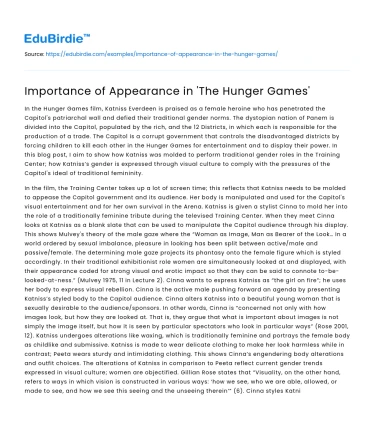In the Hunger Games film, Katniss Everdeen is praised as a female heroine who has penetrated the Capitol's patriarchal wall and defied their traditional gender norms. The dystopian nation of Panem is divided into the Capitol, populated by the rich, and the 12 Districts, in which each is responsible for the production of a trade. The Capitol is a corrupt government that controls the disadvantaged districts by forcing children to kill each other in the Hunger Games for entertainment and to display their power. In this blog post, I aim to show how Katniss was molded to perform traditional gender roles in the Training Center; how Katniss’s gender is expressed through visual culture to comply with the pressures of the Capitol's ideal of traditional femininity.
In the film, the Training Center takes up a lot of screen time; this reflects that Katniss needs to be molded to appease the Capitol government and its audience. Her body is manipulated and used for the Capitol's visual entertainment and for her own survival in the Arena. Katniss is given a stylist Cinna to mold her into the role of a traditionally feminine tribute during the televised Training Center. When they meet Cinna looks at Katniss as a blank slate that can be used to manipulate the Capitol audience through his display. This shows Mulvey's theory of the male gaze where the “Woman as Image, Man as Bearer of the Look… In a world ordered by sexual imbalance, pleasure in looking has been split between active/male and passive/female. The determining male gaze projects its phantasy onto the female figure which is styled accordingly. In their traditional exhibitionist role women are simultaneously looked at and displayed, with their appearance coded for strong visual and erotic impact so that they can be said to connote to-be-looked-at-ness.” (Mulvey 1975, 11 in Lecture 2). Cinna wants to express Katniss as “the girl on fire”; he uses her body to express visual rebellion. Cinna is the active male pushing forward an agenda by presenting Katniss’s styled body to the Capitol audience. Cinna alters Katniss into a beautiful young woman that is sexually desirable to the audience/sponsors. In other words, Cinna is “concerned not only with how images look, but how they are looked at. That is, they argue that what is important about images is not simply the image itself, but how it is seen by particular spectators who look in particular ways” (Rose 2001, 12). Katniss undergoes alterations like waxing, which is traditionally feminine and portrays the female body as childlike and submissive. Katniss is made to wear delicate clothing to make her look harmless while in contrast; Peeta wears sturdy and intimidating clothing. This shows Cinna’s engendering body alterations and outfit choices. The alterations of Katniss in comparison to Peeta reflect current gender trends expressed in visual culture; women are objectified. Gillian Rose states that “Visuality, on the other hand, refers to ways in which vision is constructed in various ways: ‘how we see, who we are able, allowed, or made to see, and how we see this seeing and the unseeing therein’” (6). Cinna styles Katniss depending on the agenda. At the beginning of the film, she is styled as a strong and fierce woman. At the very end, after her rebellious act with the poisonous berries, Cinna changes her appearance to convince the Capitol that she was not acting in defiance but rather out of love and desperation. To emphasize her innocence and harmlessness Cinna dresses her in a childlike yellow dress, in order to appease the Capitol.
Save your time!
We can take care of your essay
- Proper editing and formatting
- Free revision, title page, and bibliography
- Flexible prices and money-back guarantee
In addition, Effie and Haymitch (mentors) also help to mold Katniss’s image to conform to the Capitol's gender norms. Effie teaches Katniss how to perform as a female in the Capitol; teaches the Capitols gendered mannerisms like smiling and walking in heels. Haymitch knows the importance of sponsors in order to survive in the arena. He advises Katniss to act as Peeta’s lover to gain the audience's sympathy. Haymitch and Effie want Katniss to act as what Milestone and Meyer define as emphasized femininity, which 'centers on women's compliance with subordination and the accommodation of men's interests and desires. Women are presented as 'naturally' kind and caring... women are said to want love and commitment...'(Milestone & Meyer 2012, 20). In the Arena, Katniss acknowledges that when she acts as Peeta’s lover she receives supplies from sponsors, and she realizes that her performance of femininity ensures her survival.
Milestone and Meyer's reading show how gender is produced, represented, and consumed in popular culture to form gendered identities (Milestone & Meyer 2012, 1). Gender identities of the Capitol are produced through the media, 'the media are symbolic institutions because their products signify. media texts construct meanings through the use of language and images...construct certain meanings, for example conveying a particular message or creating a narrative' (4). In the Capitol, 'gender hierarchies and inequalities are maintained by meanings and belief systems, and these are in turn generated through representation' (8). The Arena has cameras everywhere for the Capitol audience’s consumption. Cynthia Weber states that “it [Imagining America at War] challenges the separation of theaters of culture from theaters of war' (Weber 2009, 8). She argues that films tell us about the world; films construct a worldview, not an escape. I would argue that The Hunger Games film is an exaggerated view of current society.
In conclusion, the aim of this blog post is to show how Katniss was molded by her stylist and mentors to perform traditional gender roles to comply with the pressures of the Capitol's ideal gender norms.






 Stuck on your essay?
Stuck on your essay?

